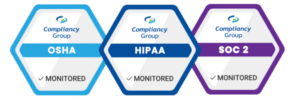The Importance of Access Management in Healthcare
Access management in healthcare refers to the process of controlling and monitoring who views protected health information (PHI). The Health Insurance Portability and Accountability Act (HIPAA) requires organizations working in healthcare to comply with the “minimum necessary standard.” This means that entities and individuals should only access the minimum necessary PHI to perform their job function. Implementing access management allows organizations to ensure that PHI is only accessed by authorized individuals, and is not accessed excessively.
What is Access Management in Healthcare?
To adhere to the “minimum necessary standard” by implementing access management in healthcare, it is important to give each employee unique login credentials to access devices, the organization’s internal network, and their physical site. Providing employees with unique login credentials, allows for actions to be attributed to specific individuals, enabling organizations to monitor access to PHI.
By monitoring employee access to data, an organization is able to determine regular access patterns for each employee. Without access management, it is difficult to determine who accesses what and for how long.
Why is Access Management Important?
Access management is particularly important for detecting internal threats to an organization. Organizations that implement access management are able to quickly detect insider threats. By documenting normal access patterns for each employee, organizations are able to easily recognize when an employee is acting with malicious intent. When employees are acting outside of their normal behavioral patterns, it is likely that they are accessing data for personal reasons.
An employee may access data out of curiosity, for profit, or in retaliation. Perhaps an employee recognizes a patient that comes in or maybe a celebrity is a patient, an employee may access their files without cause to satisfy their curiosity. An employee may also access patient data without cause for financial gain by selling patient information to those wishing to commit identity theft, or selling celebrity PHI to a gossip site.
Lastly, a disgruntled employee may access PHI without cause for malicious intent. The employee may delete or corrupt files, or steal data. All of the above reasons are why it is imperative to implement access management, and change access levels for employees changing job roles or leaving the organization.
Modifying and Blocking Access Rights
Insider threats are a real concern that organizations must take seriously. As such it is important to modify or block access rights for employees that change job roles or leave the company.
A 2019 survey conducted by Ivanti, an IT firm, found that:
- 55% of respondents confidently changed access privileges for employees that changed job roles within the organization
- 26% of respondents reported that it took more than a week to remove access privileges for employees that left the organization
- 50% of IT professionals were confident that access had been blocked to critical systems for the employee that most recently left their organization
- 52% reported that they knew someone that was able to access data or systems of their former employer
According to respondents, the biggest perceived risks for failing to modify or block access were:
- 38% stated sensitive data leakage by a former employee was the biggest risk
- 26% cited cyberattacks due to unmanaged accounts was the biggest risk
- 24% believed malicious data theft was the biggest risk
The main issues identified by respondents to modifying or blocking access were:
- 24% cited poorly defined processes as the main issue
- 23% stated issues with automation as the main issue
- 10% cited lack of resources as the main issue
When changing or revoking access levels:
- 54% said they had to change access manually
- 37% had some form of automation
- 9% said access management changes were fully automated
Implementing Access Management
To implement access management, organizations without a dedicated IT staff should consult an expert to ensure that their data is protected. IT professionals can provide employees unique login credentials that enable different levels of access to data based on an employees job role. In addition, when employees leave the organization or change job roles, access levels can be easily adjusted.




